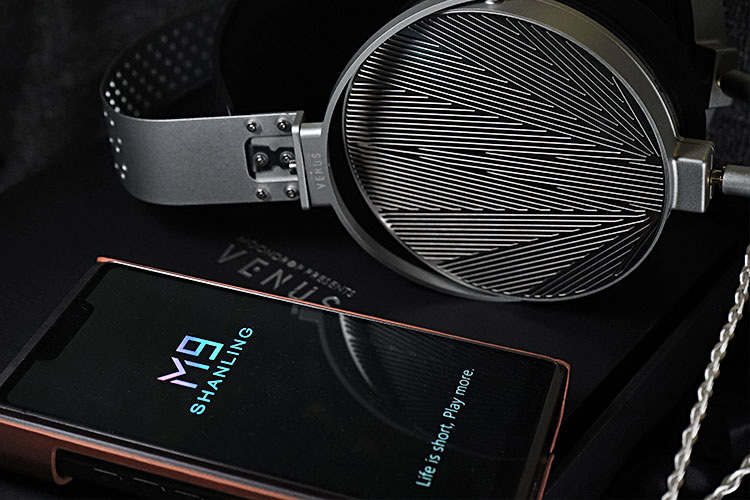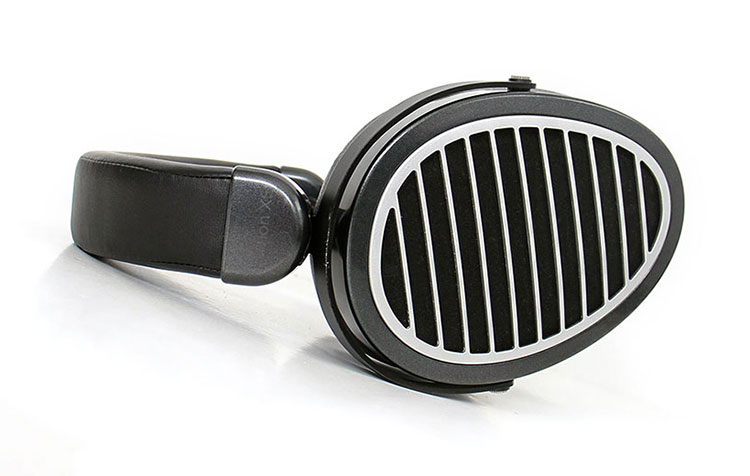Synergy
Efficiency
The Venus is rated at 18Ω and 100dB/Vrms @1kHz in sensitivity. It is obvious that it is a relatively power-hungry driver that requires stronger voltage swings to unleash its full potential, though it still sounds dynamic and resolving on powerful portable sources.
The rather unintrusive tuning and moderately low sensitivity allow the Venus to scale up with power nicely without bringing out any harshness in the treble and ensuring some decent dynamic range.
Pairings
Testing with the Shanling M7 player with the highest gain setting, the Venus sound is very smooth and elaborated in the upper mids, the staging is wide, and the vocal image is slightly more dispersed than on the FiiO K7.
Despite the staging being slightly confined compared to desktop amplification pairings, it still sounds fairly defined with a small hint of sweetness coming from the soft lower mids and the more protruded higher vocal notes.
The Shanling M9 has a stronger treble transient performance and the decoding quality is a better match that shapes the vocal image offering more depth and height to the staging performance.
Although there is still room for the Venus to sound more euphonic with bigger amplifiers, I consider this a more accessible setup and quite enjoyable.
On the K9 Pro ESS, there is a higher power in the output that immediately clears up the low end to enhance layering and definition.
Also, it sounds more stereophonic, dense, and full-bodied in the midrange frequencies, rendering the height and depth even more clearly and pictures the output much more realistic.
Select Comparisons
Moondrop Void
$199.99
Technical
The Moondrop Void was released at a similar time to the Venus and is supposed to be a lower-end, portable model designed for on-the-go use.
The Void features a self-developed 50mm high-performance dynamic driver with a composite diaphragm and CCAW voice coil inside.
This dynamic technology-based headphone is rated 64Ω and 110dB in sensitivity, looking slightly hard to drive on paper but is responsive to power and can be driven quite well on a weaker source.
Design
When I heard the name Void, I thought it was going to be a black or at least, a dark-colored item but I was wrong.
The Void comes in an all-white, injection-molded housing that looks clean and classy. Like the HD650 you can peep into the earcups through the grills to look at the driver beneath.
The whole construction with interchangeable cables is sturdy and well-built for the price and looks very neat.
Performance
Priced friendlier, it is quite clear that the Void is positioned slightly lower down the line compared to the Venus and the electrostatic headphone ZERO.
I did not have a chance to listen to the ZERO yet, but for the Void, it clearly much easier to drive and displays a similar tuning to the Venus where the upper vocal range is subtly boosted for more presence.
Both the Void and Venus share a V-shaped signature that allows the vocal to be smoothly presented, however, the Void is more easily driven, and it sounds quite dynamic even with my Shanling M3X.
The Venus will require a lot more power to power it adequately and when you have the right source, it can sound much more accurate, expanded, and delicate in treble control and positioning of instruments.
With a larger and faster membrane on the Venus, it stretches the perceived stage wider and much more stereophonic. Whereas on the Void, the vocal image will sound more compressed and less separated from the backing even when driven by powerful sources.
If you do not have a powerful amplifier or listen mainly on the go, then the Void would be a much more appropriate choice.
The tuning also allows it to sound smooth and rather resolving on pretty much any device. The Venus is technically a lot more proficient but at the same time, it is much more source-dependent.
HIFIMAN Edition XS
$499
Technical
The HIFIMAN Edition XS is one of the more popular planar headphones under the same price bracket as the Venus.
Featuring Stealth Magnet Technology and NEO Super-nano diaphragm, the frequency response measures 8Hz – 50kHz, and its impedance is rated at 18oΩ with 92dB sensitivity. Compared to the Venus, the Edition XS is less sensitive and requires as much if not more power to be driven well.
The two headphones show some similarities in their design where the Edition XS arranges its magnet array to reduce diffraction when the wave generated by the membrane passes through.
A similar implementation of ‘second-time’ stress balance technology can be seen on the Venus which achieves a similar effect by the shape and spacing of the magnets.
Design
The Edition XS weighs just 405g and is quite a bit lighter than the Venus which is constructed fully in metal with a larger earcup diameter.
As such the Venus feels much more solid and masculine compared to the Edition XS which is partially built from plastic.
With the self-adjustable headband on the Venus, it feels more comfortable, and the clamping is less strong on my head.
The oval-shaped ear cups on the Edition XS allow users to find the sweet spot more easily, however, for long listening, I find the Venus slightly more comfortable.
Performance
The Edition XS exhibits a stronger V-shaped signature and leans slightly more to the treble end. I find it a more typical “planar tuning” compared to the Venus that colors the lower vocal and midrange frequencies warmer and fuller with a fuller body.
The Edition XS requires more swing and gain to unleash its full potential and that is also one reason why the output results in a cleaner tone.
Testing with Jazz and woodwinds, the Edition XS reaches higher notes more effortlessly and airily, it pushes out more exciting details in the harmonics, and that makes synthesized instruments more thrilling and expansive.
The Venus is more balanced tonally and outlines voice more distinctively, acoustic instruments sound more natural and realistic. They are also positioned more up front with a denser image.
On the FiiO K7, the Venus has a slightly stronger transient performance in the bass, it also sounds more full-bodied and elaborated while the Edition XS is marginally less resolving and layered.
Overall, I find the Venus easier to power than the Edition XS. It sounds more defined and more elaborated in the vocal range as well.
Our Verdict
Moondrop is a very new brand for headphone making but their original, robust design and tuning approach to the Venus has proven to be very competitive.
The bold and solid assembly reminds me of the Abyss AB-1266 but at a much friendlier price, plus there is very pleasing fidelity and efficiency achieved with some unusual engineering on the key parts.
The Moondrop Venus has successfully captured the merits of a planar magnetic design, sounding incredibly spacious but not hollowed. The performance, the sweetened tuning, and the build quality are excellent for the price.
Moondrop Venus Technical Specifications
- Impedance: 18Ohms
- Sensitivity: 100dB/Vrms @1kHz
- Frequency Response: 6Hz-80kHz
- Connectors (on ear-cups): 3.5mm
- Cables: 3.5mm / 4.4mm





